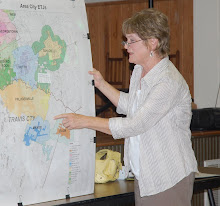Peggy Fikac of the Houston Chronicle has an interesting article about the attempt to resurrect the failed bullet-train attempt of the 1990’s. She reports on the recent briefing of legislators by the Texas High Speed Rail and Transportation Corp.
High-speed rail boosters are hoping to have a $12 billion to $18 billion bullet-train system by 2020. One difference between the previous plan and this one is the diagram of the routes. The past plan featured a large hub in Milam County with tentacles stretching out to Dallas, San Antonio/Austin, and Houston. The new plan shows a north/south line from Dallas, through Austin, to San Antonio, with a junction in Temple/Killeen with a line to Houston.
Officials, cities, counties, and airlines—still TOP-DOWN
Robert Eckels, High Speed Rail chairman, said the previous effort failed “primarily because it was a top-down model driven by lobbyists out of Austin.” Evidently he was implying that the current effort is a grass-roots effort. However, the high-speed rail consortium is composed of elected officials, cities, counties, and two airlines. This sounds like another top-down model to me. I don’t see any mention here of actual residents whose land would be taken.
Those of us who remember the previous plan to put the bullet train through Eastern Williamson County, including Coupland and its surrounding farms, know that the previous plan failed, as communities were organizing to fight it, because it was not financially feasible and lost its financial backing.
Just what we need—more taxpayer money going to corporations
These boosters say their project will be a public-private partnership, with money from taxpayers for private corporations.
Sen. John Carona, a Republican from Dallas who is chair of the Senate Transportation and Homeland Security Committee, and who sometimes is on the sensible side of issues, is on the non-sensible side of this one. He has proposed a constitutional amendment to exempt the bullet train from property taxes. Luckily, it will require a two-thirds vote in the Legislature plus voter approval.
Martha Estes, who sent this article around, comments, “More TAX subsidies for private investors?? Let private enterprise carry its own load!! It looks like the Blackland Prairie is part of the route.” If this is such a viable plan, why does it need government involvement? Once again, this brings us back to the plan for the Corridor—the state is involved as the entity that can take private property from citizens for the benefit of private corporations.
See the map at
http://www.chron.com/disp/dispcomp2.mpl?cid=15039043
and see Peggy Fikac’s entire article at
http://www.chron.com/disp/story.mpl/front/6235582.html
Subscribe to:
Post Comments (Atom)

No comments:
Post a Comment